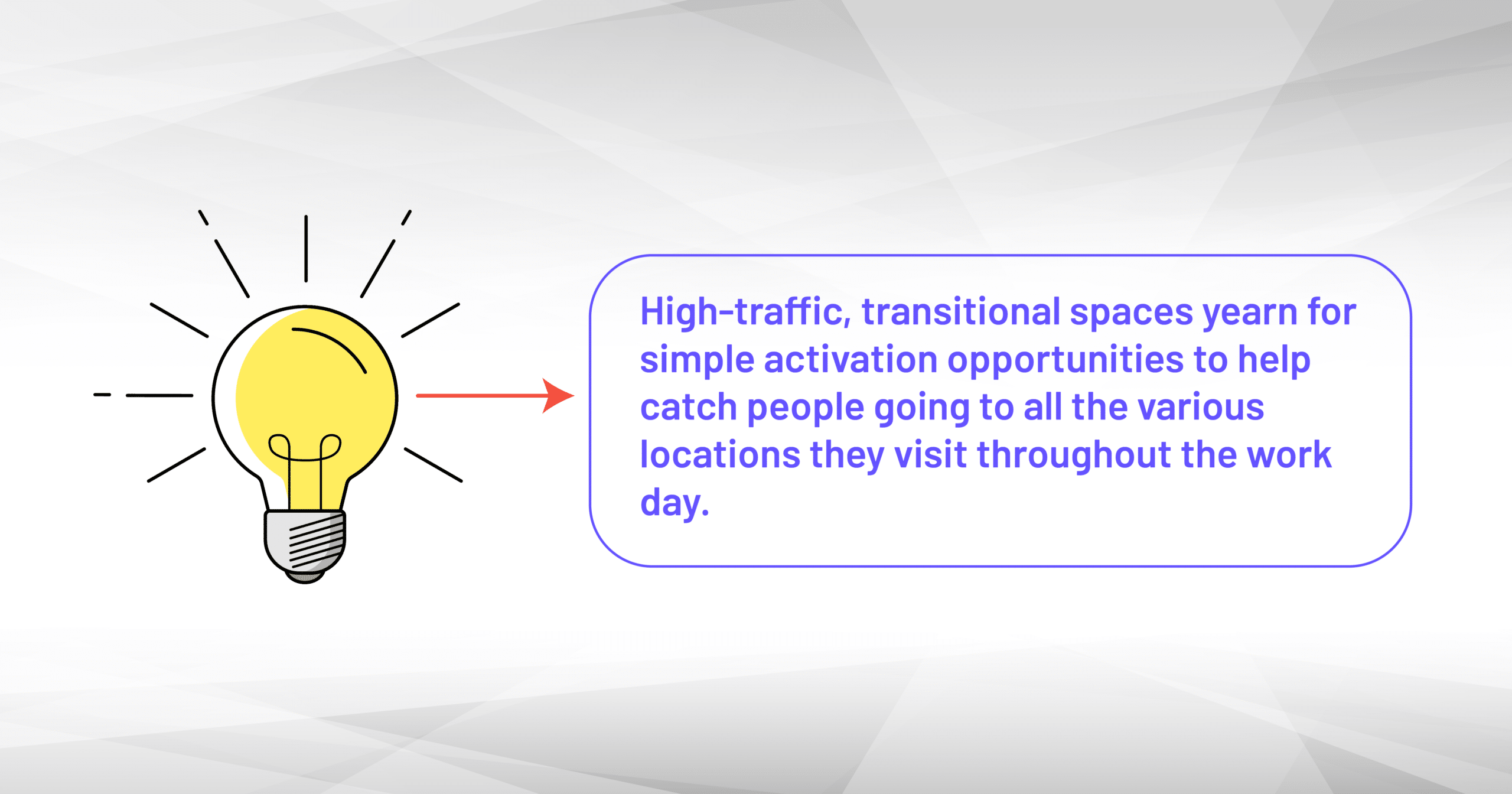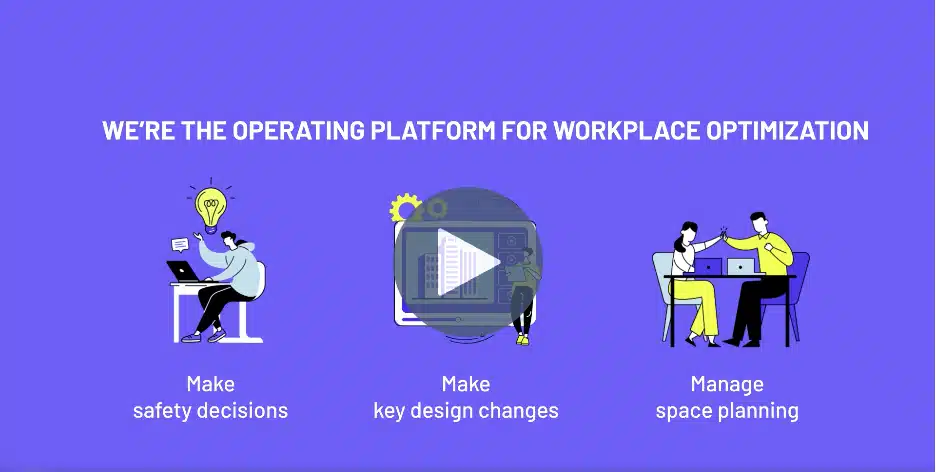When an office seamlessly functions for the employee, the end-user doesn’t notice it–they intuitively experience it.
Good design isn’t seen
“Good” design isn’t seen and provides an engaging space where people naturally want to be. When this happens, innovative moments between co-workers often occur but getting that perfect design is a nuanced journey and unique to the company. For example, the design elements that work for a 50 person ad agency, won’t always work for an enterprise company with thousands of distributed, global employees.
With that being said, certain design theories can help spark spontaneous interactions that often fuel innovative conversations, regardless of company size. As noted by Scott Birnbaum, VP of Samsung Semiconductor, “creative ideas aren’t going to come while sitting in front of your monitor.” They’ll happen when spaces are “designed to spark not just collaboration but that innovation you see when people collide.”
One of those theories is Encounter Theory which suggests that “exposure to others in the office–particularly those you may not interact with in your current projects–opens the door to opportunities that an employee would not otherwise find.”
Creating spaces that allow for “collisions”
According to Harvard Business Review, “creating collisions–chance encounters and unplanned interactions between knowledge workers, both inside and outside the organization–improves performance.”
Data supporting this isn’t new either. Co-working spaces have long been advocates of creating collisions. In a 2011 survey of over 1,500 co-workers in over 50 different countries, collisions contributed to a 75% increase in productivity as well as an 83% increase in trust in their fellow coworkers. 
What design elements help create these types of interactions?
If you want to create more collisions, consider all the areas of the office that are usually “dead” space. Placing lounges, tech support, or other employee service areas–that vary in size–in circulation spaces is a great way to increase casual collisions and serendipitous interactions. These high-traffic, transitional spaces yearn for simple activation opportunities to help catch people going to all the various locations they visit throughout the work day.
For example, here are some typically dead spaces that can be used to create collisions among people who wouldn’t normally interact with each other:
- Hallways
- Staircases
Hallways
Instead of being a means of getting from point A to B, consider how you might re-design hallways to create more collisions:
- Narrowing them: Of course, you’ll want to keep in mind that hallways should be functional and designed according to Universal Design Standards to ensure they’re accessible. However, what if you made them just narrow enough where more people felt more apt to saying “hello” to one another, instead of opting with the awkward half grin and nod?
- Widening them: On the flip side, widening hallways allows for casual seating areas that can encourage friendly passersby to interact in between meetings and work.
- Adding art–visual and/or auditory: Adding photographs and paintings to hallways make them feel more like an art gallery than a hallway. You could also play upbeat music in hallways to reduce the awkwardness of silently walking towards someone. Art is a de-stressor, relaxer, and naturally allows people to let their guard down.
Staircases
The design of internal, open office staircases are more important than you may think. While they do increase the amount of natural light in a space, they also provide an increased “incentive” for employees to walk between different floors and levels of the office.
At a base level, staircases provide visibility of the physical movement of others. For example, if your office’s cafeteria is on the bottom or top floor, people working on their respective floors will be able to see groups of people make their way for lunch which can subliminally queue others to do the same.
Open staircases are more than a way to connect floors–they’re strategically designed mechanisms that can foster connection and collaboration. “By putting different amenities on different floors, employees have more opportunities to connect with coworkers through casual collisions.”
Internal staircase landings can also be accompanied by small seating areas. Similar to the idea of widening hallways, placing micro lounge areas with couches and comfy seating options close to the tops and bottoms of staircases, allow those who have casually collided to quickly–and naturally–step aside to connect.
Co-working spaces like WeWork and Industrious engage in this subtle design feature. At the top, bottom, and sometimes middle of the internal staircases at many of their locations feature micro lounges. For an example, click here.

Innovative spaces don’t have hierarchies
Spaces that fuel innovation by way of casual collisions and serendipitous interactions don’t have hierarchies–they’re democratized and provide an equal playing field for employees to connect with each other, no matter their seniority.
Historically, the “prime” pieces of real estate in the office were reserved for executives. For example, blocks of private offices and boardrooms have been exclusively utilized by executives and upper leadership. These spaces had the best views and locations while mid and entry level employees were stuck in less appealing nooks of the office for their individual workspaces, meeting rooms, and social areas.
Desegregating spaces among teams and hierarchies is one of the first steps in flattening your office culture and most importantly, driving office engagement. To lead by example, many executives are giving up their coveted corner offices and realizing that in order to attract people back to the office, making room for more social and collaborative spaces is more important than having a private space.
As noted by Oisin Hanrahan, CEO at Angi, giving up his private office “lends itself to a flatter organization–it feels more approachable and breaks down barriers between the leadership and the folks who run the business.” If one of the incentives of returning to the office is that employees can see–and be seen–by senior executives, then democratizing the spaces and creating hubs for interaction will certainly encourage the return.
Merging physical and digital workspaces
While encouraging people to participate in casual collisions in a physical office is a worthwhile endeavor, it’s important to not ostracize those who work mostly–if not totally–remote. It is estimated that only 17% of employees want to be in the office every day. This means that the workspaces of tomorrow must be able to seamlessly merge physical and digital work environments.
The future of “phygital” work
The phygital workplace of tomorrow must provide an equitable working experience for both in-person and remote workers. And while remote workers will inevitably miss out on certain spontaneous interactions, as technology advances, so should the mechanisms that allow all employees to engage in virtual collisions.
In 2021, the virtual reality market was valued at $21 billion and is expected to grow at a CAGR rate of 15% from 2020 to 2030. This growth isn’t just for gamers and recreation either. Long before Microsoft and Facebook integrated virtual reality for meetings amidst the “explosion of the word ‘metaverse,’” many companies seized the opportunity to respond to the wide adoption of remote work with virtual office solutions.
From HP and Cisco’s smarter conference room technologies to WeWork’s experimentation with hologram technology for meetings and events–it is becoming increasingly important that company’s start to explore how they will integrate physical and digital realms.
In short, the virtual office is coming, whether you’re ready or not. And while incentivizing and trying to draw people back to the office is important, so is a workplace tech stack that allows physical and virtual work to be seamlessly integrated.
Incremental improvements and changing mindsets
Designing hybrid environments that spark innovation will require an iterative mindset. There’s no silver bullet or cookie-cutter framework that will automatically spark innovation by way of casual collisions and serendipitous interactions. The hybrid environment is new to most everyone and evolving our workspaces will take incremental improvements that are tailored to the demands of your unique workforce.
Strategically designing the offices of tomorrow
Providing hybrid offices to employees can’t be accomplished with pre-pandemic processes for workplace design. Why? Because they’re inefficient, rely on static communications, and have too many siloed tools that don’t always communicate with each other.
Strategically designing the offices of tomorrow requires agile processes and tools to accommodate the ad-hoc changes and updates to your design. This endeavor also needs a single source of truth to engage multiple stakeholders with varying degrees of expertise and the ability to immerse them in the design process.
To learn more about how Saltmine can be your strategic design partner on evolving your office to a modern one–as well as help you simplify the workplace design and strategy process–click the image below:
Enjoying our blog? Be sure to subscribe to stay up-to-date on Saltmine's original content with the form below!
 by
by 